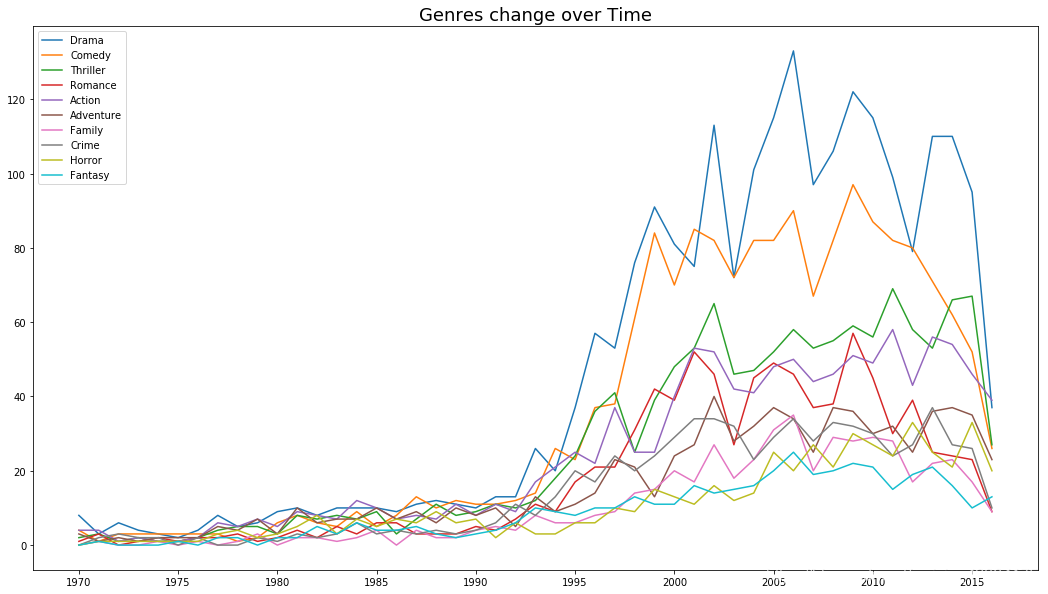kaggle电影数据分析
项目背景:
客户是一个电影制作的新公司,他们将制作一部新电影。客户想确保电影能够成功,从而使新公司立足市场。
提出问题:
- 电影类型是如何随着时间的推移发生变化的?
- Universal Pictures 和 Paramount Pictures
之间的对比情况如何? - 改编电影和原创电影的对比情况如何?
- 电影页面查看次数与评分次数的相关关系?
理解数据:
数据来源
数据来源于Kaggle项目数据
TMDB 5000 Movie Dataset
导入数据
import numpy as np # linear algebra
import pandas as pd # data processing, CSV file I/O (e.g. pd.read_csv)
moviesDf = pd.read_csv("../input/tmdb_5000_movies.csv")
creditsDf = pd.read_csv("../input/tmdb_5000_credits.csv")
moviesDf.head(2)
creditsDf.head()
观察得知,movies中的id列和credits中的movie_id列呈对应关系,因此链接合并两个数据集。
fullDf = pd.merge(moviesDf,creditsDf,right_on='movie_id',left_on='id',how='left')
fullDf.head(2)
查看数据集的行列数,描述统计信息,缺失情况,各列数据类型
# fullDf.shape //查看数据集行列数
# fullDf.describe() //描述统计情况,查看最小值,异常值
fullDf.info() //查看缺失值情况,以及各列的数据类型
经观察,budget、vote_count、
vote_average、revenue最小值为0,列中可能有异常值;homepage、overview、release_date、runtime、tagline列均有数据缺失
数据清洗
数据预处理
- 选择子集
选择需要进行分析的数据列作为数据子集 - 列名重命名
fullDf = fullDf[['id','popularity','budget','revenue','original_language','spoken_languages','cast','crew','title_x','status','keywords','runtime','genres','production_companies','release_date','vote_count','vote_average']]
titleDict={'title_x':'title'}
fullDf.rename(columns=titleDict,inplace=True)
- 缺失数据处理
fullDf.loc[fullDf["release_date"].isnull(),'title']
fullDf['release_date'] = fullDf['release_date'].fillna('2014-06-01') #查询到空白数据的实际上映时间
fullDf['runtime'] = fullDf['runtime'].fillna(fullDf['runtime'].mean()) #均值填充
- 数据类型转换
将json格式的字符串转换为python格式的字符串
在这里遇到了很多问题,如json.load()和json.loads()的区别
json.loads()
将json格式的字符串解码转换成Python对象
json.dumps()
实现python类型转换为json字符串,返回一个str对象
json.dump()
将python内置类型序列化为json对象后写入文件
json.load()
读取json形式的字符串元素,转换为python类型
import json
json_col = ['genres','keywords','crew','production_companies','production_countries','spoken_languages','cast']
for i in json_col:
fullDf[i]=fullDf[i].apply(json.loads)
for index,i in zip(fullDf.index,fullDf['genres']):
list1=[]
for j in range(len(i)):
list1.append((i[j]['name']))
fullDf.loc[index,'genres']=str(list1)
for index,i in zip(fullDf.index,fullDf['keywords']):
list1=[]
for j in range(len(i)):
list1.append((i[j]['name']))
fullDf.loc[index,'keywords']=str(list1)
for index,i in zip(fullDf.index,fullDf['crew']):
list1=[]
for j in range(len(i)):
list1.append((i[j]['name']))
for index,i in zip(fullDf.index,fullDf['production_companies']):
list1=[]
for j in range(len(i)):
list1.append((i[j]['name']))
fullDf.loc[index,'production_companies']=str(list1)
for index,i in zip(fullDf.index,fullDf['production_countries']):
list1=[]
for j in range(len(i)):
list1.append((i[j]['name']))
fullDf.loc[index,'production_countries']=str(list1)
for index,i in zip(fullDf.index,fullDf['spoken_languages']):
list1=[]
for j in range(len(i)):
list1.append((i[j]['name']))
fullDf.loc[index,'spoken_languages']=str(list1)
for index,i in zip(fullDf.index,fullDf['cast']):
list1=[]
for j in range(len(i)):
list1.append((i[j]['name']))
fullDf.loc[index,'cast']=str(list1)
将日期的datetime数据类型转换为日期,并提取出年份月份
fullDf['release_year']=pd.to_datetime(fullDf['release_date'],format='%Y-%m-%d').dt.year
fullDf['release_month']=pd.to_datetime(fullDf['release_date'],format='%Y-%m-%d').dt.month
fullDf.drop(columns=['release_date'])
- 数据排序
按照发行年月进行升序排列
fullDf=fullDf.sort_values(by=['release_year','release_month'],ascending='True')
fullDf=fullDf.reset_index(drop='True')
fullDf.drop(columns=['release_date'])
- 异常值处理
将最小值0用平均值填充
fullDf['budget']=fullDf['budget'].replace(0,fullDf['budget'].mean())
fullDf['vote_count']=fullDf['vote_count'].replace(0,fullDf['vote_count'].mean())
fullDf['revenue']=fullDf['revenue'].replace(0,fullDf['revenue'].mean())
fullDf['vote_average']=fullDf['vote_average'].replace(0,fullDf['vote_average'].mean())
fullDf.drop(columns=['release_date'])
提取特征——数据分类
- 数值类型的数据:
id、popularity、budget、revenue、runtime、vote_count、vote_average - 时间序列数据:
release_date,已转换为单独的年份release_year、月份列release_month - 分类数据:
有直接类别的数据:
status,original_language
字符串类型:
spoken_languages、cast、crew、genres、 production_companies、production_countries
构建模型
- 电影类型随着时间的推移发生的变化
#电影类型是如何随着时间的推移发生变化的?
#选取年份及某种类型电影的数量分别作为X及Y轴
#提取年份范围
min_year=fullDf['release_year'].min()
max_year=fullDf['release_year'].max()
#提取电影类型
fullDf['genres']=fullDf['genres'].str.strip('[]').str.replace(' ','').str.replace("'",'')
fullDf['genres']=fullDf['genres'].str.split(',')
liste_genres=set()
for s in fullDf['genres']:
liste_genres=set().union(s,liste_genres)
liste_genres=list(liste_genres)
#构建模型
genre_df=pd.DataFrame(index=liste_genres,columns=range(min_year,max_year+1))
genre_df=genre_df.fillna(value=0)
year=np.array(fullDf['release_year'])
z=0
for i in fullDf['genres']:
split_genre=list(i)
for j in split_genre:
genre_df.loc[j,year[z]]=genre_df.loc[j,year[z]]+1
z+=1
genre_df
选取数量排在前11名的电影类型,选取1970年以后的数据
genre_df=genre_df.sort_values(by=2005,ascending=False)
genre_df=genre_df.iloc[0:10,-48:-1]
genre_df
import matplotlib.pyplot as plt
plt.figure(figsize=(18,10))
plt.plot(genre_df.T)
plt.title('Genres change over Time',fontsize=18)
plt.xticks(range(1970,2020,5))
plt.legend(genre_df.T)
plt.show

- 比较Universal Pictures和Paramount Pictures两家公司发行的电影类型
# Universal Pictures和Paramount Pictures之间的对比情况如何?
# 以两家公司名标记制作公司栏
for i in fullDf['production_companies']:
if 'Paramount Pictures' in i:
i = 'Paramount Pictures'
elif 'Universal Pictures' in i:
i = 'Universal Pictures'
else:
i = ''
fullDf['production_companies'] = fullDf['production_companies'].str.strip('[]').str.replace("'",'')
parDf = fullDf.loc[fullDf['production_companies']=='Paramount Pictures']
uniDf = fullDf.loc[fullDf['production_companies']=='Universal Pictures']
com_gen_df=pd.DataFrame(index=liste_genres,columns=['Paramount','Universal'])
com_gen_df=com_gen_df.fillna(value=0)
for i in parDf['genres']:
split_genre = list(i)
for j in split_genre:
com_gen_df.loc[j,'Paramount']=com_gen_df.loc[j,'Paramount']+1
for i in uniDf['genres']:
split_genre = list(i)
for j in split_genre:
com_gen_df.loc[j,'Universal']=com_gen_df.loc[j,'Universal']+1
com_gen_df.head()
# 选取排名前10的电影类型
com_gen_df=com_gen_df.sort_values(by='Paramount',ascending=False)
Par_gen_df=com_gen_df.iloc[0:9,]
com_gen_df=com_gen_df.sort_values(by='Universal',ascending=False)
Uni_gen_df=com_gen_df.iloc[0:9,]
# 绘图
fig=plt.figure('Paramount VS Universal',figsize=(13,6))
ax=fig.add_subplot(121)
ax.set_title('Paramount Top 10 Genres')
ax.pie(x=Par_gen_df['Paramount'],labels=Par_gen_df.index,shadow=True,autopct="%1.1f%%",labeldistance=1.1,startangle=90,pctdistance=0.6)
ax=fig.add_subplot(122)
ax.set_title('Universal Top 10 Genres')
ax.pie(x=Uni_gen_df['Universal'],labels=Uni_gen_df.index,shadow=True,autopct="%1.1f%%",labeldistance=1.1,startangle=90,pctdistance=0.6)
plt.show()

- 原创电影和改编电影之间的对比情况如何?
# 改编电影adaption和原创电影original对比情况如何
a='based on novel'
fullDf['if_original']=fullDf['keywords'].str.contains(a).apply(lambda x:'no_original' if x else 'original')
key_count=fullDf['if_original'].value_counts()
plt.figure(figsize=(6,6))
plt.title('The proportion of Adaption & Original Film')
plt.pie(x=key_count,labels=key_count.index,labeldistance=1.1,autopct='%1.1f%%')
plt.show()

- 评分次数和电影页面查看次数的相关关系如何?
# 建立模型vote_count与popularity相关系数为0.77
x = fullDf['vote_count']
y = fullDf['popularity']
# 拆分训练数据和测试数据
from sklearn.model_selection import train_test_split
x_train,x_test,y_train,y_test=train_test_split(x,y,train_size=0.8)
plt.scatter(x_train,y_train,color='blue',label='train')
plt.scatter(x_test,y_test,color='red',label='test')
plt.xlabel('vote_count',fontsize=12)
plt.ylabel('popularity',fontsize=12)
plt.legend(loc=2)
plt.show()

# 导入模型
from sklearn.linear_model import LinearRegression
x_train=x_train.values.reshape(-1,1)
x_test=x_test.values.reshape(-1,1)
trainmodel=LinearRegression()
trainmodel.fit(x_train,y_train)
# 最佳拟合线 a=截距 b=回归系数
a=trainmodel.intercept_
b=trainmodel.coef_
print(a,b)
7.769665509560758 [0.01948283]
plt.scatter(x_train,y_train,color='blue',label='train')
y_train_pred=trainmodel.predict(x_train)
plt.plot(x_train,y_train_pred,color='black',label='best lines')
plt.xlabel('vote_count',fontsize=12)
plt.ylabel('popularity',fontsize=12)
plt.legend(loc=1)
plt.show()

# 评估模型
trainmodel.score(x_test,y_test)
0.6055473056494662







 浙公网安备 33010602011771号
浙公网安备 33010602011771号